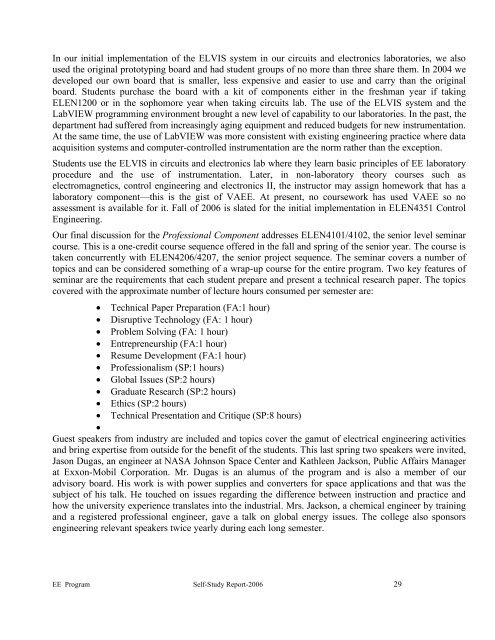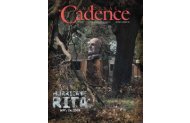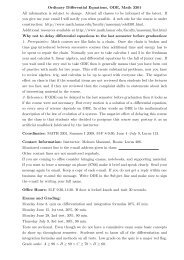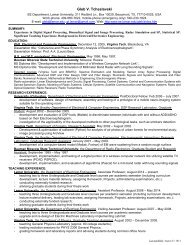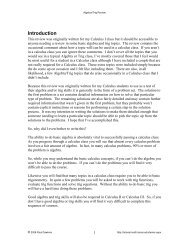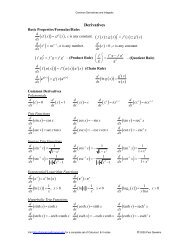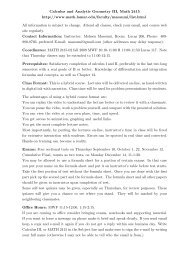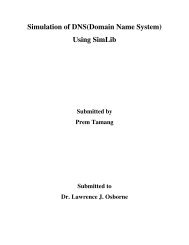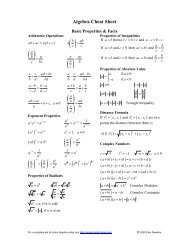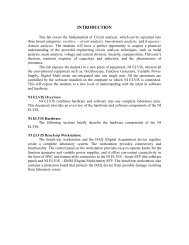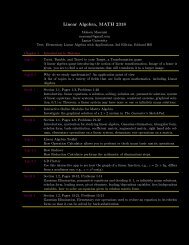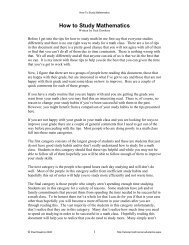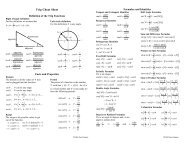program self-study report - Lamar University Electrical Engineering
program self-study report - Lamar University Electrical Engineering
program self-study report - Lamar University Electrical Engineering
You also want an ePaper? Increase the reach of your titles
YUMPU automatically turns print PDFs into web optimized ePapers that Google loves.
In our initial implementation of the ELVIS system in our circuits and electronics laboratories, we alsoused the original prototyping board and had student groups of no more than three share them. In 2004 wedeveloped our own board that is smaller, less expensive and easier to use and carry than the originalboard. Students purchase the board with a kit of components either in the freshman year if takingELEN1200 or in the sophomore year when taking circuits lab. The use of the ELVIS system and theLabVIEW <strong>program</strong>ming environment brought a new level of capability to our laboratories. In the past, thedepartment had suffered from increasingly aging equipment and reduced budgets for new instrumentation.At the same time, the use of LabVIEW was more consistent with existing engineering practice where dataacquisition systems and computer-controlled instrumentation are the norm rather than the exception.Students use the ELVIS in circuits and electronics lab where they learn basic principles of EE laboratoryprocedure and the use of instrumentation. Later, in non-laboratory theory courses such aselectromagnetics, control engineering and electronics II, the instructor may assign homework that has alaboratory component—this is the gist of VAEE. At present, no coursework has used VAEE so noassessment is available for it. Fall of 2006 is slated for the initial implementation in ELEN4351 Control<strong>Engineering</strong>.Our final discussion for the Professional Component addresses ELEN4101/4102, the senior level seminarcourse. This is a one-credit course sequence offered in the fall and spring of the senior year. The course istaken concurrently with ELEN4206/4207, the senior project sequence. The seminar covers a number oftopics and can be considered something of a wrap-up course for the entire <strong>program</strong>. Two key features ofseminar are the requirements that each student prepare and present a technical research paper. The topicscovered with the approximate number of lecture hours consumed per semester are:• Technical Paper Preparation (FA:1 hour)• Disruptive Technology (FA: 1 hour)• Problem Solving (FA: 1 hour)• Entrepreneurship (FA:1 hour)• Resume Development (FA:1 hour)• Professionalism (SP:1 hours)• Global Issues (SP:2 hours)• Graduate Research (SP:2 hours)• Ethics (SP:2 hours)• Technical Presentation and Critique (SP:8 hours)•Guest speakers from industry are included and topics cover the gamut of electrical engineering activitiesand bring expertise from outside for the benefit of the students. This last spring two speakers were invited,Jason Dugas, an engineer at NASA Johnson Space Center and Kathleen Jackson, Public Affairs Managerat Exxon-Mobil Corporation. Mr. Dugas is an alumus of the <strong>program</strong> and is also a member of ouradvisory board. His work is with power supplies and converters for space applications and that was thesubject of his talk. He touched on issues regarding the difference between instruction and practice andhow the university experience translates into the industrial. Mrs. Jackson, a chemical engineer by trainingand a registered professional engineer, gave a talk on global energy issues. The college also sponsorsengineering relevant speakers twice yearly during each long semester.EE Program Self-Study Report-2006 29


